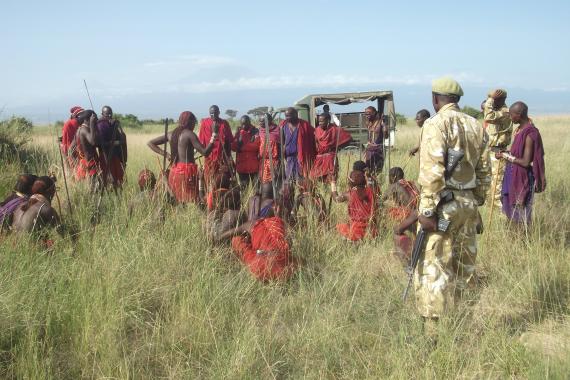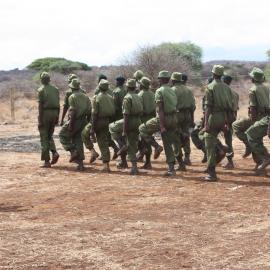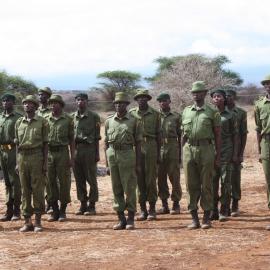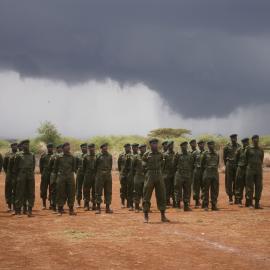The Greater Kilimanjaro Landscape
Published

Members of the Maasai communities are employed as community scouts. Credit: African Wildlife Foundation
The Greater Kilimanjaro area – a 25,623 km2 transboundary landscape that spans the Kenya–Tanzania border – is a critical region for elephant, lion and other species. Effective collaboration between local communities, NGOs and national wildlife authorities has proven successful in anti-poaching efforts, and more broadly in protecting the region’s wildlife.
The project, which brings together communities, the African Wildlife Foundation, Big Life Foundation, Kenya Wildlife Service, Tanzania Wildlife Division and Tanzania National Parks, started in 2001.
Anti-poaching activities are seen as one element in a programme which is also focussed on developing community-based tourism, community capacity building, grazing management, livestock improvement and compensation schemes for loss from wild animal predators. All of contributed to a decrease in poaching.
Lead
Location
The Kilimanjaro landscape is a mosaic of ownership and land use. Protected areas include Amboseli, Kilimanjaro, and Chyulu Hills National Parks; there are community lands, such as group ranches and Wildlife Management Areas (WMA); private land includes former group ranches that have been subdivided and are held in title by Maasai. The whole area is home to around 1,930 elephants, as well as other animals, such as lions, cheetah and black rhino.
The poaching and wildlife trade problem
Species affected African Elephant Loxodonta africana
Products in tradeIvory for international markets.
Overview of the problem
Strong wildlife protection laws exist in both Kenya and Tanzania, but there remains a growing threat of elephant poaching in the area. This is driven by the rising consumer demand for ivory – mostly in Asia – and the presence of corruption in the region.
Poachers are mainly outsiders, with local Maasai rarely involved. The current value of ivory in Beijing is US$2,100 per kilogramme; a local poacher receives less than US$200 per kg.
The anti-IWT initiative
Throughout the area, community engagement in wildlife protection is integral to formal anti-poaching programmes. The Big Life Foundation, with support from the African Wildlife Foundation (AWF), and working closely with Kenya Wildlife Service and the Tanzania Wildlife Division, oversees anti-poaching in the region
The strategy
Strengthening disincentives for illegal behaviour
Big Life – whose senior staff include individuals drawn from the local communities – provides training and coordination for 200 community scouts who provide routine surveillance, anti-poaching and monitoring activities on community and private land.
Increasing incentives for wildlife stewardship
Conservation jobs are highly popular. Working as a guide or in a tourism facility all confer prestige, as well as offering training and an income.
Revenue is generated from hunting (in Tanzania).
Increasing livelihoods that are not related to wildlife
Social benefits such as water services, schools, bursaries and medical facilities.
Has the initiative made a difference?
Joint transborder patrolling, increased coordination amongst all parties, mobile units and sharing of intelligence has resulted in a poaching decline. Between 2013 and 2014 the Kenyan side recorded a 54 per cent decrease in elephant poaching, while there has been no known elephant poaching on the Tanzanian side since 2012.
What works and why
The key to the project’s success lies in its collaborative partnership and a holistic approach to conservation. The parties have succeeded in leveraging each other’s skills and resources, while recognising specific roles and responsibilities.
Anti-poaching activities are seen as one element in a programme which is also focussed on developing community-based tourism, community capacity building, grazing management, livestock improvement and compensation schemes for loss from wild animal predators.
The integration of these varied activities results in protection of wildlife and land in a way that directly engages and benefits local communities.
Conservation jobs are highly popular. Working as a wildlife scout, as a guide or in a tourism facility all confer prestige, as well as offering training and an income. There are risks involved in anti-poaching activities – notably from possible encounters with armed poachers – but also from dealing with the difficult community relations that arise if a local person is killed by elephants. Generally speaking, such risks are balanced by the benefits of community engagement in wildlife protection. They receive training, revenue from tourism, revenue from hunting (in Tanzania), management engagement and leadership roles (on Group Ranch and WMA committees), ownership of tourism facilities, and social benefits such as water services, schools, bursaries and medical facilities. Another significant factor is that the region is mainly inhabited by Maasai pastoralists whose traditional way of life depends on open rangelands. Conservation activities help to maintain these rangelands, as well as creating additional jobs and revenue through tourism.
Lessons learned:
- Community engagement in wildlife protection needs professional management from experienced anti-poaching specialists.
- Consistency – in terms of funding, benefits, engagement and management – is key.
- Long term commitment – and therefore funding – is needed to identify and develop community conservation scouts, to maintain a presence in the region and to ensure a sustainable effect on wildlife conservation.
What doesn’t work and why
- The benefits from wildlife-based revenues do not impact every member of local communities; a single community poacher can have a negative impact.
- Population increases in the area means more pressure on wildlife, and more opportunities for human-wildlife conflict, with resulting animosity towards wildlife.
- Opportunity costs increase as agriculture expands into the area’s wetlands, floodplains and rivers, with resulting sub-division of land for crop production.
- The increase in demand and rising price of ivory creates a significant incentive for community members to poach.
- The Tanzanian Wildlife Division is slow to release funds that are collected in WMAs and due back to the communities
Organisers, donors and partners
For further information contact People Not Poaching coordinator (peoplenotpoaching@gmail.com).


